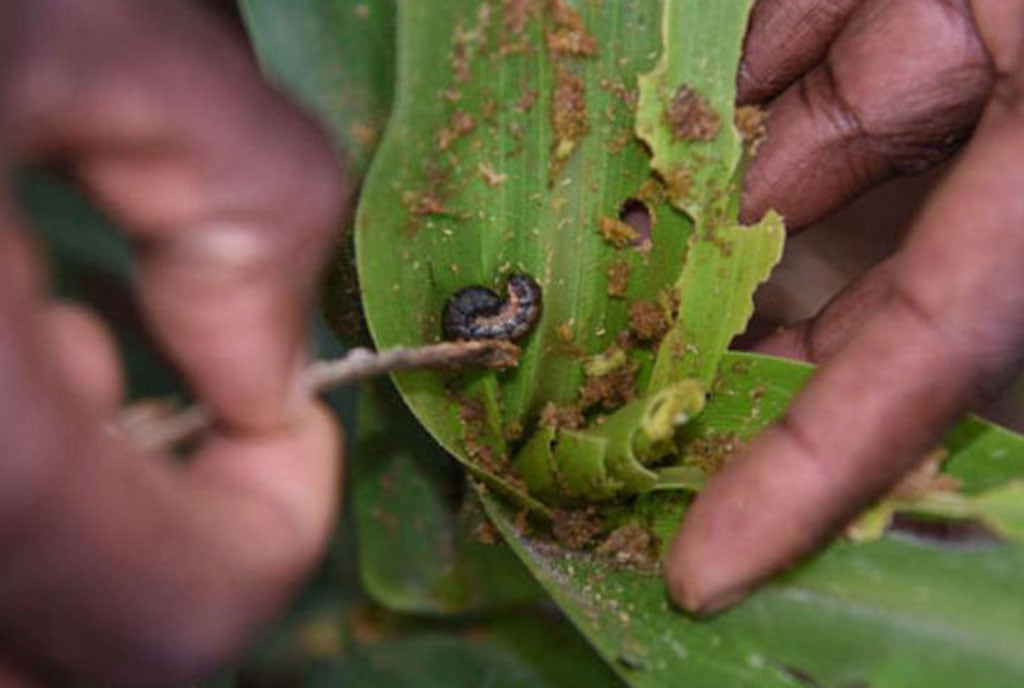
Pests are dangerous and affect crop production. PHOTO/COURTTESY
|How to use trap crops to control pests on your farm
What you need to know:
- The researchers say trap crops keep the pests in the border area, reducing numbers of pests and disease spreading on the unsprayed cash crop in the centre and preserving natural enemies.
- Researchers, however, recommend that trap crops such as sorghum should also be harvested and their remains burned or buried deep into the soil as they may act as a pest reservoir in the following season.
Farmers who have struggled to tame pests are recording increased yields and reduced pest infestation on their crops thanks to certain crops such as sorghum, napier grass and desmodium among others which are naturally capable of containing pests at minimal or no cost.
The crops known as trap crops have also enabled farmers to reduce the cost of pesticides which amounts to 30 percent of all farmers’ expenses. In some districts such as Masindi and Kiryandongo farmers have reduced the destruction of maize by stem borers by planting maize alongside sorghum.
“With a perimeter ring of sorghum plants around the maize plots, we have noted less damage from birds and the borers. Birds such as weaver birds prefer the sorghum thereby saving our maize from attack,” says Philip Muhumuza, a farmer in Kisindi village, Masindi District.
Increased yields
The farmers have also realised increased yields after surrounding their crops with napier grass as well. A recent research conducted at the Kenya Agricultural and Livestock Research Organisation (KARLO) has shown that pigeon peas planted along the borderline of an okra plot significantly reduced aphid infestation-increasing yield of the okra crop.
A similar study also shows that using a trap crop ‘ of napier grass surrounding maize and an intercrop of the legume desmodium, repelled the insect pests and suppressed a parasitic weed, Striga hermonthica.
How trap crops work
The researchers say trap crops keep the pests in the border area, reducing numbers of pests and disease spreading on the unsprayed cash crop in the centre and preserving natural enemies.
Researchers, however, recommend that trap crops such as sorghum should also be harvested and their remains burned or buried deep into the soil as they may act as a pest reservoir in the following season.
For instance, the larva stages of stalk borers bore into the stems of sorghum waiting for the rainy season to transform into adult butterflies and lay eggs on the young maize. Burning the crop residues of sorghum and maize stalks at the end of the season breaks the cycle.
“This technique eliminates the use of broad-spectrum pesticides on the cash crop, which helps preserve natural enemies and helps prevent resurgence of the primary pest population, secondary pest outbreaks and additional spraying. It results in improved crop quality and dramatic pesticide savings. It reduces the cost of production and improves quality of produce as the amount of chemical residues in the harvest is lowered. It also delays development of pesticide resistance,” says the report by Karlo.
Benefits to farmers
Beyond the primary role of controlling pests, trap crops can be beneficial to farmers.
“While we are not very interested in their grain, we still harvest some sorghum, which we can use as porridge flour or use to feed chicken. The dry sorghum stalks can be used as fodder or fuel wood especially in the cold season in July,” noted Muhumuza as he tends his three-and-half acre price of land.
Soil fertility
Researchers noted that there was improvement in soil fertility leading to increased maize yields from 39 percent to 129 percent.
Cattle were also able to obtain fodder from napier and desmodium legumes. Of further importance is the reported suppression of striga weed by trap crops.
Striga reduces maize and cowpea yields by up to 80 percent in Sub-Saharan Africa, threatening over 100 million people.
“Striga currently remains the biggest threat to maize production, particularly in the East Africa region where maize is the staple for millions of inhabitants,” said Mel Oluoch, head of the Integrated Striga Management in Africa programme at the International Institute of Research in Tropical Agriculture (IITA)
The weed attaches itself on the root sucking the sap and starving the crop of vital nutrients absorbed from the ground. A combination of a Napier grass trap crop and a legume intercrop in a plot of maize has been known to significantly decline the population of Striga weeds ultimately boosting overall yields. Agricultural extensions workers have recommended trap crops to limit the damage to important food crops by pests.
Key facts
The weed attaches itself on the root sucking the sap and starving the crop of vital nutrients absorbed from the ground.
A combination of a napier grass trap crop and a legume intercrop in a plot of maize has been known to significantly decline the population of striga weeds ultimately boosting overall yields.
Agricultural extensions workers have recommended trap crops to limit the damage to important food crops by pests.




